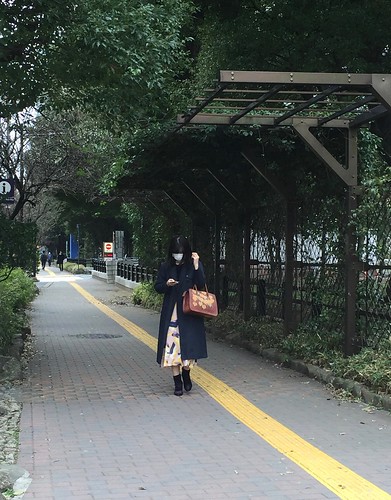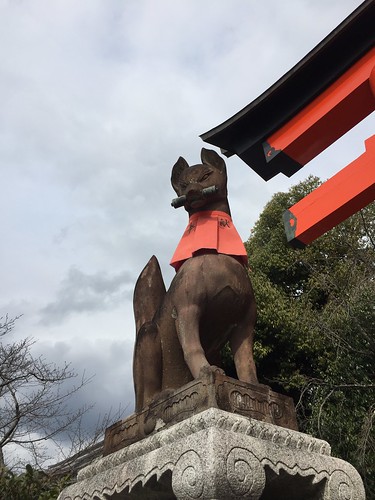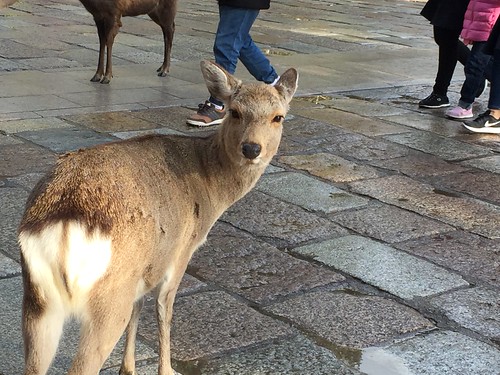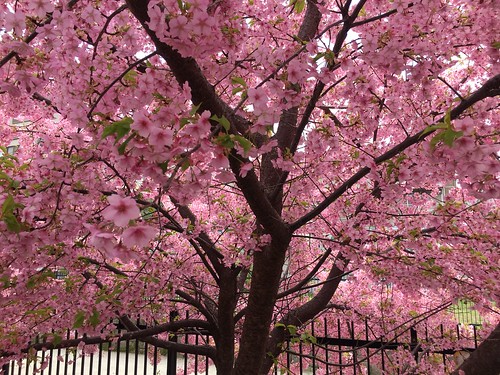In Japan, I did not know many things. I went without studying beforehand, yet I stepped forward with both a sensation and an openness.

Each gate is donated by a business person
I knew that Shinto and Buddhist shrines were important, but how so? I did not know.
I knew that the people were respectful and honorable, that the culture was rich, and that perfection, or let’s say the striving for perfection, is paramount.
I understood that beauty and precision were intrinsically interwoven, and I knew that I would observe this aspect of creation in Japan. This country was truly the crowning jewel of my trip to Asia. Let me try to explain.

Seeing all
To bloom, we must bud
The cherry blossoms were not yet out in Tokyo. There were buds, anticipatory and delicate. But early March was still, well…early March. Kind of grey and cloudy.
But then, spilling out of the Imperial Hotel onto the seemingly drab grounds of Hibiya Park were hundreds of young Japanese women, adding brilliant splashes of color. Celebrating their graduation from university, they wore kimonos with the traditional hakama skirt, flowers in their hair, and giddy smiles on their faces. Oh my!

Traditional dress: kimono with hakama

Splash of color for the future
Trying to imagine the wisteria lane in bloom, I noticed that the beauty was already present. I captured a photo of a fashionable young woman, her outfit complete with face mask, a ubiquitous sight in this land.

Tokyo style
Later that evening on the 43rd floor of a remarkable restaurant, a dinner was served to honor this time - that moment of holding back, right before it happens. The dessert—a tiramisu cake placed delicately beneath a sprig of a cherry tree, its grey speckled bark allowing a tiny pink bud to push out—sat next to a confection of pink sugar and frosting depicting what was to come: full bloom.

Anticipating the blossom
Sacred shrines for ancient connection
The first Shinto shrine I visited was nearby Osaka, a city just south of Kyoto. On International Women’s Day, a young man named Tai had been tasked with showing me and another woman the surrounding area, and our first stop was, coincidentally, a shrine to a Goddess. Tai showed us how to cleanse ourselves before going into the Shinto temple, and that it is best to walk on the sides of the walkway toward the shrine, as the central path is reserved…for the Goddess. Legend has it that this particular deity unleashes jealousy and envy, if any are harbored within couples that visit the shrine together, and so it seems that there are a fair number of break-ups or separations that occur. “It is best to visit this shrine alone,” advises Tai…“that is, without your boyfriend.”
And, sure enough…most of the people visiting did not appear to be couples. Ironically, this Goddess is said to help with love and partnership. Which I guess makes sense: you weed out the jealousy and envy to make room for a more perfect love. Yes, I understand.

Shinto shrine entrance gate

Sacred space for all
I especially enjoyed Tai’s lesson on how to cleanse before entering a Shinto shrine, and the rituals involved in offering a hope, dream, or blessing once inside. Spring water is available in a well with long handled ladles, located nearby the entrance. After filling the ladle, use the water to rinse the left hand, then the right, and then pour a small amount of water from the right into the left palm, and using the water from your palm, rinse out your mouth, making sure not to swallow the water. There is a small area below the spring where “used water” goes. Then, allow the remaining water in the ladle to run back along the handle, in order to cleanse it for the next person. One must be sure to replace the ladle empty, back to its resting spot above the spring. You are then cleansed, and ready to enter.
Shinto and Buddhism are the primary spiritual practices in Japan. Shinto is more of a philosophy than a religion, and establishes rituals for present day Japan to connect to its ancient past. Everything in nature has a spirit, from rocks and trees to rivers and mountains, so there is much ritual related to reinforcing the connection between the earth and the human experience. No distinction is made between the spirit of a human and the spirit of nature — they both have “kami,” an energy that generates their existence. This felt familiar to me, as my own spiritual practices often reflect native American ways of honoring the natural world.
Entering the shrine with reverence, an offering of a coin is thrown into a wooden box, covered with slats. As you stand before a hidden mirror, which represents your own internal reflection and mindfulness of your visit, you hold your wish or hope in your mind, bow twice and then clap your hands three times. I observed many renditions of this—always bows and claps, but some did 3:2, some 1:3, and some 2:2. Interesting. I decided not to ask Tai about this difference. Instead, I noticed that each person was meditative and focused, and left with a serious smile, a look of relief. I took my turn, and paused inside this beautiful conduit for “kami,” marveling at a connection that felt like a discovery.
Afterwards, many persons wrote their wishes on a small wooden tablet, which they then left at the shrine. On the front side of each tablet was a picture of a wild boar, as it is the Year of the Pig. These tablets looked like a collection of ornaments, swaying in the soft breeze.

Leaving and letting go
As I walked back to the car in silence, I felt as if I may have been granted a genie wish. Something was up, here.
Shrines in Kyoto, Nikko, Nara
One place where I long to return and spend more time…much more time…would be Kyoto.
There is something quite magical there, and I was only able to receive a taste of it. It honestly felt like I was a child, and there was this incredibly delicious meal that was placed in front of me, and I got my chopsticks out, took a couple of savory bites, and then turned around and the dish had been whisked away! Part of the reason for this feeling was that was exactly what happened. Because we were, at that time, traveling as a foursome, I wasn’t able to go off on my own and linger in areas that called to me.
My recommendation would be that when visiting the two places described below, plan on having the time to be. There. And maybe even go there completely off season. I guess I was in the “shoulder season”, which is the time before the high tourism for cherry blossoms. However, there were still too many people for my liking. After all, these are sacred places, meant to be revered with silence, meditation, and awareness.

Yasaka Shrine

Golden Pavilion
Yasaka Shrine and Fushimi Inari-taisha Shrine are both Shinto shrines near Kyoto. In northern Kyoto, we also visited a Zen temple, Kinkakuji (Golden Pavilion). I was captivated by them all, but especially by Fushimi Inari-taisha because of one thousand torii gates. As I viewed these gates winding through the woods from a nearby vantage point (see photo below), I was immediately reminded of the installation in Central Park in 2005 where bright orange fabric was installed to form a gate-like sensation. Sure enough, this memory was meaningful. Christo and Jeanne-Claude, the artists who installed “The Gates” in Central Park, were inspired by the torii gates of the Fushimi Inari-taisha shrine! I love it when this happens. I wanted to walk and walk and walk through all of the gates, and yes…I did walk through hundreds. But I wanted more. Just like a child. Sigh…

Torii gates in the woods
Our guide explained that Inari is a Shinto god of rice, which was historically viewed as affecting good fortune for all agriculture. Eventually the shrine became equated with the good fortune of all forms of business, so many Japanese visit this shrine to ask for blessings for their business ventures. Foxes are Inari’s messengers, and they surround the shrine in many forms.

Shinto diety of rice
Two additional shrines not to miss in Japan are located in Nikko and Nara, both easily accessible by bullet trains. Nikko Tosho-gu is a Shinto shrine that has a rich history of shogun samurai, mythology and folklore. The shogun founder’s tomb is there. A Buddhist temple complex in Nara, Todai-ji, is massive, and appears to seek an understanding of our place in the world. That is, I felt very very small. The deer that roam the streets here are sacred, and have learned to bow to request rice crackers, which has become a famous draw for tourists. I was more impressed by the gigantic bronze Buddha, and the fact that this temple is built with only wood; no metal fasteners are used to reinforce it. Precision.

Bronze Buddha Todai-ji

Nara sacred deer

Nikko Tosho-gu
All of these places were more than I felt I could comprehend in such a short visit. It is only now that I am remembering how and why they moved me.
Full Bloom!
The guide that took us to the Torii gate shrine said that he had a bit of a surprise for us. Apparently there are some “early bloomer” cherry trees that only locals know about…of course, he admitted that due to the Internet, now a lot of people know. And there they were — blooming right beside a small canal in Kyoto. Absolutely stunning…

Full Bloom
The Travel to Asia: A New Understanding Series
Becky Burns, our Soulful Travel Guide, is a retired educator living in Sarasota, Florida. Her travel stories provide an interpretation of her trips around the globe on a soulful level, where she muses about coincidences, connections, and life lessons. You may follow her here at wandering educators, where she posts periodically.
All photos courtesy and copyright Becky Burns



